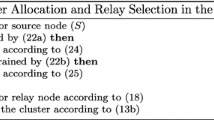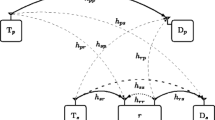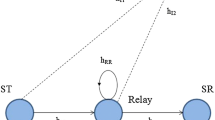Abstract
The optimization of the network throughput and transmission range is one of the most important issues in cognitive relay networks (CRNs). Existing research has focused on the dual-hop network, which cannot be extended to a triple-hop network due to its shortcomings, including the limited transmission range and one-way communication. In this paper, a novel, triple-hop relay scheme is proposed to implement time-division duplex (TDD) transmission among secondary users (SUs) in a three-phase transmission. Moreover, a superposition coding (SC) method is adopted for handling two-receiver cases in triple-hop networks with a cognitive relay. We studied a joint optimization of time and power allocation in all three phases, which is formulated as a nonlinear and concave problem. Both analytical and numerical results show that the proposed scheme is able to improve the throughput of SUs, and enlarge the transmission range of primary users (PUs) without increasing the number of hops.
Similar content being viewed by others
References
Boyd, S., Vandenberghe, L., 2004. Convex Optimization. Cambridge University Press, Cambridge, UK.
Chen, X., Huang, J., 2012. Distributed spectrum access with spatial reuse. IEEE J. Sel. Areas Commun., 31(3):593–603. http://dx.doi.org/10.1109/JSAC.2013.130323
Chen, X., Huang, J., 2015. Imitation-based social spectrum sharing. IEEE Trans. Mob. Comput., 14(1):1189–1202. http://dx.doi.org/10.1109/TMC.2014.2347052
Elgendi, M., Nasr, O.A., Khairy, M.M., 2014. Cooperative multicasting based on superposition and layered coding. IET Commun., 8(3):267–277. http://dx.doi.org/10.1049/iet-com.2013.0167
Guimarães, F.R.V., da Costa, D.B., Tsiftsis, T.A., et al., 2014}. Multiuser and multirelay cognitive radio networks under spectrum-sharing constraints. IEEE Trans. Veh. Technol., 63(1):433–439. http://dx.doi.org/10.1109/TVT.2013.2275201
He, J., Xu, C., Li, L., 2012. Power saving for cooperative spectrum sharing-based cognitive radios under primary user short-term rate protection. IET Commun., 6(9):1097–1103. http://dx.doi.org/10.1049/iet-com.2011.0456
Huang, H., Li, Z., Si, J., et al., 2015. Underlay cognitive relay networks with imperfect channel state information and multiple primary receivers. IET Commun., 9(4):460–467. http://dx.doi.org/10.1049/iet-com.2014.0429
Jo, M., Maksymyuk, T., Batista, R.L., et al., 2014. A survey of converging solutions for heterogeneous mobile networks. IEEE Wirel. Commun., 21(6):54–62. http://dx.doi.org/10.1109/MWC.2014.7000972
Kaneko, M., Hayashi, K., Sakai, H., 2014. Superposition coding based user combining schemes for non-orthogonal scheduling in a wireless relay system. IEEE Trans. Wirel. Commun., 13(6):3232–3243. http://dx.doi.org/10.1109/TWC.2014.042114.130419
Lee, J., Wang, H., Andrew, J.G., et al., 2011. Outage probabil-ity of cognitive relay networks with interference con-straints. IEEE Trans. Wirel. Commun., 10(2):390–395. http://dx.doi.org/10.1109/TWC.2010.120310.090852
Li, P., de Lamare, R.C., Fa, R., 2011. Multiple feedback suc-cessive interference cancellation detection for multiuser MIMO systems. IEEE Trans. Wirel. Commun., 10(8): 2434–2439. http://dx.doi.org/10.1109/TWC.2011.060811.101962
Li, Y., Zhang, Z., Zhang, B., et al., 2013. Best relay selection in decode and forward cooperative cognitive radio relay networks over Rayleigh fading channels. IET Int. Conf. on Information and Communications Technologies, p.152–157. http://dx.doi.org/10.1049/cp.2013.0048
Liu, K.R., 2009. Cooperative Communications and Network-ing: Cambridge University Press, Cambridge, UK.
Liu, X., Tan, X.Z., 2014. Optimization algorithm of periodical cooperative spectrum sensing in cognitive radio. Int. J. Commun. Syst., 27(5):705–720. http://dx.doi.org/10.1002/dac.2377
Lu, W., Wang, J., 2014. Opportunistic spectrum sharing based on full-duplex cooperative OFDM relaying. IEEE Com-mun. Lett., 18(2):241–244. http://dx.doi.org/10.1109/lcomm.2013.122713.132038
Lu, W., Wang, J., Li, F., et al., 2013. An anti-interference cooperative spectrum sharing strategy with full-duplex. 19th IEEE Int. Conf. on Networks, p.1–4. http://dx.doi.org/10.1109/ICON.2013.6781939
Luo, Z.Q., Yu, W., 2006. An introduction to convex optimiza-tion for communications and signal processing. IEEE J. Sel. Areas Commun., 24(8):1426–1438. http://dx.doi.org/10.1109/JSAC.2006.879347
Shin, E.H., Kim, D., 2011. Time and power allocation for collaborative primary-secondary transmission using su-perposition coding. IEEE Commun. Lett., 15(2):196–198. http://dx.doi.org/10.1109/LCOMM.2011.122810.101486
Shoukry, H., Zlatanov, N., Jamali, V., et al., 2014. Achievable rates for the fading three-hop half-duplex relay network using buffer-aided relaying. IEEE Global Communica-tions Conf., p.1716–1721. http://dx.doi.org/10.1109/GLOCOM.2014.7037056
Spectrum Efficiency Working Group, 2002. Report of the Spectrum Efficiency Working Group. Federal Commu-nications Commission Spectrum Policy Task Force, Washington DC,USA.
Vanka, S., Srinivasa, S., Haenggi, M., et al., 2012a. A practical approach to strengthen vulnerable downlinks using su-perposition coding. IEEE Int. Conf. on Communications, p.3763–3768. http://dx.doi.org/10.1109/ICC.2012.6364619
Vanka, S., Srinivasa, S., Gong, P., et al., 2012b. Superposition coding strategies: Design and experimental evaluation. IEEE Trans. Wirel. Commun., 11(7):2628–2639. http://dx.doi.org/10.1109/TWC.2012.051512.111622
Wang, J., Li, Y., Zhong, B., et al., 2013. Adaptive power allo-cation for decode-and-forward OFDM transmission with multi-hop relaying. IEEE/CIC Int. Conf. on Communi-cations in China, p.345–350. http://dx.doi.org/10.1109/ICCChina.2013.6671140
Zhang, Y., Sun, X., Wang, B., 2016. Efficient algorithm for k-barrier coverage based on integer linear programming. China Commun., 13(7):16–23. http://dx.doi.org/10.1109/CC.2016.7559071
Zhong, W., Chen, G., Jin, S., et al., 2014. Relay selection and discrete power control for cognitive relay networks via potential game. IEEE Trans. Signal Process., 62(20): 5411–5424. http://dx.doi.org/10.1109/TSP.2014.2347261
Author information
Authors and Affiliations
Corresponding authors
Additional information
Project supported by the Zhejiang Provincial National Natural Sci-ence Foundation (No. LQ14F020005), the National Natural Science Foundation of China (Nos. 61379123 and 61402414), and the Re-search Program of the Educational Commission of Zhejiang Province, China (No. Y201431815)
ORCID: Wan-liang WANG, http://orcid.org/0000-0001-6127-4222
Rights and permissions
About this article
Cite this article
Zhao, C., Wang, Wl., Yao, Xw. et al. Joint throughput and transmission range optimization for triple-hop networks with cognitive relay. Frontiers Inf Technol Electronic Eng 18, 253–261 (2017). https://doi.org/10.1631/FITEE.1601414
Received:
Revised:
Published:
Issue Date:
DOI: https://doi.org/10.1631/FITEE.1601414
Keywords
- Decode-and-forward (DF)
- Triple-hop
- Cognitive relay networks (CRNs)
- Time and power allocation
- Superposition coding




